A Zen garden is a serene outdoor space designed for reflection and tranquility, often featuring elements like rocks, gravel, and minimalistic plants. These gardens invite you to unwind and find peace, making them perfect for meditation or simply taking a breath in a busy day.
The Importance of Water Features
Water features are a key component of any zen garden, adding both beauty and tranquility. In the image, we see a serene pond surrounded by carefully placed rocks. The gentle flow of water from the fountain creates a soothing sound that enhances the peaceful atmosphere.
The pond serves as a reflective surface, mirroring the trees and sky above. This connection with nature helps to ground us and promotes relaxation. The thoughtful design encourages visitors to pause and appreciate the beauty around them.
Having water in a zen garden also attracts wildlife, such as birds and butterflies. This adds life and movement to the space, making it feel more vibrant. Overall, water features play a significant role in creating the calm and restorative environment that zen gardens are known for.
Symbolism of Rocks in Zen Gardens
Rocks play a key role in Zen gardens. Each stone holds significance, representing mountains, islands, or the natural world. Their placement is intentional, creating a sense of balance and harmony.
In many ways, rocks symbolize stability and permanence. They remind us of nature’s endurance, standing firm against the tests of time. The different shapes and sizes of rocks also reflect the diversity of life, encouraging mindfulness and contemplation.
The arrangement of rocks often tells a story. For instance, a carefully placed stone may symbolize a pathway or a journey. This invites visitors to reflect and engage with the garden on a deeper level, promoting peace and tranquility.
Zen gardens invite us to slow down. Rocks, in their stillness, encourage us to take a moment to breathe and connect with nature. They create a serene environment that enhances meditation and mindfulness practices.
The Art of Raking Patterns
Raking patterns in a zen garden is a practice that combines mindfulness with creativity. The image shows beautifully crafted lines in the sand, each stroke intentional and calming. This art form encourages a sense of peace as you focus on the rhythmic motion of the rake.
The patterns can vary, from simple circles to complex geometric shapes. Each design has its own meaning and can represent elements of nature, such as rivers or waves. When you rake, you create a temporary art piece that changes with each session.
Spending time in a zen garden allows for reflection and relaxation. The act of raking can be meditative, offering a break from daily routines. Whether you’re a beginner or have experience, each stroke is a chance to express yourself and connect with nature.
History and Origins of Zen Gardens
Zen gardens, also known as Japanese rock gardens, have a rich history that dates back to the 6th century. They were inspired by the natural landscapes of China and adapted by Japanese monks. These gardens served as places for meditation and reflection, creating a serene environment.
The image above beautifully captures a traditional Zen garden, showcasing smooth sand patterns, carefully placed rocks, and surrounding trees. This layout symbolizes mountains and rivers, encouraging viewers to immerse themselves in nature. Each element is chosen for its significance, creating a tranquil atmosphere.
Over time, Zen gardens evolved to reflect different philosophies and styles. They became popular among the samurai and the elite, further enhancing their cultural importance. Today, they are appreciated worldwide for their calming effects and aesthetic beauty.
Plants Perfect for Zen Gardens
Zen gardens create a peaceful retreat, and choosing the right plants is key. The image showcases beautifully shaped greenery that complements the serene vibe of a zen garden.
Moss is a fantastic option. It brings a soft, lush feel to the landscape. It thrives in shaded areas, making it easy to maintain. Plus, its vibrant green color pops against the stones.
Bamboo is another great choice. This plant adds height and texture, creating a natural screen that promotes privacy. Its gentle rustling in the wind can be quite soothing.
Consider adding small flowering plants too. Varieties like Japanese irises or azaleas can burst with color while still keeping the tranquil theme. They’re not only beautiful but also attract friendly pollinators.
Rocks and gravel are essential in zen gardens. They symbolize water and bring an element of calm. The contrast between the plants and hardscape adds depth, making the garden more visually appealing.
Meditative Practices in Zen Gardens
Zen gardens are perfect places for finding peace and clarity. The image shows a person meditating in a serene setting, surrounded by nature. This scene captures the essence of what a Zen garden is all about: simplicity and tranquility.
The path made of stones leads the way to a peaceful spot, where one can sit and reflect. The greenery and gentle curves of the landscape create a calming atmosphere, inviting you to pause and breathe. It’s easy to see why many people turn to these gardens for meditation and mindfulness.
Practicing meditation in a Zen garden allows for a deep connection with nature. The sounds of rustling leaves and distant birds can help clear your mind. This setting encourages you to let go of distractions and focus inward. Just a few moments of stillness in such a beautiful space can help recharge your spirit.
To make the most of your time in a Zen garden, find a comfortable spot, close your eyes, and take deep breaths. Allow nature to envelop you. Whether you choose to sit quietly or engage in mindful walking, every moment spent here can enhance your well-being.
Key Elements of Zen Gardens
Zen gardens are a peaceful retreat. They often feature a mix of gravel, stones, and plants, all arranged in a way that promotes calm and reflection.
The gravel in the image shows how it can be carefully raked to create patterns. These patterns symbolize water ripples and add a sense of movement to the stillness of the garden.
Stones play a significant role too. They can represent mountains or islands. In this image, a few rocks are visible, grounding the space and adding texture.
Plants are an essential component as well. They bring life and color, contrasting beautifully with the neutral tones of the gravel and stones. Here, you can see vibrant green leaves peeking through, highlighting nature’s simplicity.
Overall, a zen garden captures the essence of tranquility and balance. Each element, from the raked gravel to the strategic placement of stones and plants, works together to create a serene environment.
Creating a Mini Zen Garden at Home
Creating a mini Zen garden at home is a great way to bring a touch of tranquility into your space. Imagine a shallow tray filled with fine sand, perfectly raked to create gentle waves. The image highlights a simple setup with smooth stones and a small rake, elements that are common in Zen gardens.
This setup invites you to reflect and relax. The small rocks represent mountains or islands, while the sand symbolizes water. Each element has its purpose and brings a sense of balance. You can customize your mini Zen garden with different materials, like colored sand or unique stones.
To get started, you’ll need a tray, sand, stones, and a small rake or stick. Arrange the stones and rake the sand to create your desired patterns. It’s a fun and calming activity that allows you to express your creativity while promoting mindfulness.
Position your garden in a spot where you can enjoy it daily. Whether on a desk or a coffee table, it will serve as a reminder to take a moment for yourself. Tending to your Zen garden can be a soothing ritual, helping you clear your mind and find your center.
Incorporating Color into Zen Gardens
Zen gardens are often known for their simplicity and tranquility. However, introducing color can bring a lively twist to the traditional design. In the image, we see vibrant flowers like sunflowers and roses, beautifully arranged among smooth stones and greenery. This splash of color enhances the overall aesthetic, making the garden more inviting.
Plants and flowers can be strategically placed to create focal points. For instance, the bright yellow sunflower stands out against the muted tones of the stones. This contrast not only adds visual interest but also lifts the spirit. The careful selection of hues can evoke different feelings, from calm to joyful.
Another way to incorporate color is through decorative elements. In the image, we see pots in earthy colors that blend well with nature. These elements can harmonize the look of the garden while still providing pops of color. Choosing the right materials and colors can make the garden feel balanced and serene.
Lastly, remember that color should complement the zen philosophy. The aim is to create a peaceful space. So, choose colors that resonate with your emotions. Soft pastels can offer a sense of calm, while brighter tones can energize the space. The key is to find a balance that suits your taste and enhances your zen experience.
Seasonal Changes in Zen Gardens
Zen gardens beautifully transform with the seasons, each change bringing its own charm. This image captures a vibrant scene where trees showcase blossoms and rich autumn hues. The contrast between the lush green leaves and the fiery oranges and reds creates a stunning visual display.
The carefully placed stepping stones guide the viewer’s path, inviting a moment of reflection. Each stone represents a journey, encouraging visitors to walk mindfully through the garden. The gravel, raked into patterns, adds texture while promoting serenity.
As seasons shift, the garden evolves. In spring, blossoms burst forth, signaling renewal. Summer brings lush greenery, filling the space with life. Autumn presents a fiery palette, while winter blankets the garden in soft snow, creating a peaceful landscape. Each season offers a new perspective, reminding us of the beauty of change.
The Role of Sand in Zen Gardens
In a zen garden, sand plays a vital role. It creates a calming atmosphere and invites tranquility. The image shows a rake gently gliding through the soft, white sand. This simple act can be quite meditative.
Sand represents water in these gardens. The raked patterns symbolize waves or ripples, bringing a sense of movement to the stillness of the garden. This connection to nature is important in zen philosophy.
Maintaining the sand is also a mindful practice. Raking it regularly helps keep the garden looking pristine and serves as a reminder to slow down and take a moment for oneself. It’s a beautiful blend of art and mindfulness.
Whether you’re a beginner or have experience, working with the sand can be a soothing activity. It allows for creativity while also providing a space for reflection. Zen gardens invite you to connect with your thoughts and feelings, making you feel more grounded.
Creating a Zen Garden on a Budget
A Zen garden can bring tranquility to any space, and creating one doesn’t have to break the bank. This image shows a collection of different colored pebbles, sandy soil, and a small decorative plant.
Each element adds a unique touch that contributes to the overall peaceful vibe. You can easily replicate this at home by gathering natural materials like sand, stones, and even some hardy plants that require little maintenance.
These components can be found at local gardening stores or collected from nature, making them budget-friendly options. Arranging them thoughtfully can create a stunning visual without significant costs.
Don’t hesitate to use your creativity; layering rocks and spreading sand can enhance the relaxing atmosphere you’re aiming for. Remember, simplicity is key in a Zen garden, so focus on a few well-placed items that resonate with you. This way, you can enjoy a serene retreat right in your backyard or even indoors.
Incorporating Natural Pathways
Creating a zen garden often starts with thoughtful design, and natural pathways play a key role in that process. The image showcases a beautiful stone pathway winding through a serene garden, inviting visitors to explore and unwind.
The pathway is lined with lush greenery, including various plants and trees that add life and color. This not only enhances the garden’s beauty but also fosters a sense of connection to nature.
Using stones for the pathway creates a rustic charm. Each stone is placed with care, allowing for a natural flow while ensuring stability underfoot. This attention to detail makes walking through the garden a mindful experience.
As you stroll along the path, the surrounding elements—like the vibrant foliage and the gentle architecture of the building ahead—complement the tranquility of the space. Incorporating pathways in your zen garden can guide the eye and promote a sense of exploration.
Consider adding more features along the pathway, such as benches or small water features, to encourage moments of pause and reflection. The idea is to create a harmonious environment where each element contributes to peace and relaxation.
Creating Tranquil Spaces with Zen Gardens
Zen gardens are perfect for creating a peaceful retreat right at home. The image captures a serene garden with carefully placed rocks and soothing greenery. It’s a space that invites relaxation and mindfulness.
The wooden benches provide a comfortable spot to sit and reflect. The soft texture of gravel underfoot enhances the calming effect. This design encourages a connection with nature, making it ideal for meditation or simply unwinding.
Adding elements like stones and plants helps to balance the space. Each component has its purpose, contributing to an overall sense of harmony. Imagine spending quiet moments here, surrounded by the gentle sounds of nature.
A zen garden is more than just a visual treat; it’s a way to embrace simplicity and tranquility in everyday life. Whether you have a small balcony or a large backyard, creating your own zen garden can bring a little peace to your day.
Inspiration from Nature: Landscapes in Zen Gardens
Zen gardens draw inspiration from the beauty of nature. In this serene scene, we see a blend of sand, rocks, trees, and water. Each element plays a role in creating a peaceful atmosphere.
The trees stand tall against a backdrop of mountains and a shimmering lake. This combination reminds us of the balance between nature and tranquility. The carefully placed rocks invite visitors to stop and reflect, while the gentle curves in the sand evoke calming waves.
The sky above adds to the feeling of openness and freedom, as clouds drift lazily by. It’s a perfect spot for meditation or simply enjoying the scenery. The design elements in this zen garden promote harmony, inviting everyone to connect with the natural world.
Use of Lanterns and Lighting in Zen Gardens
Zen gardens often feature lanterns that serve both practical and aesthetic purposes. These lanterns illuminate pathways and create a serene atmosphere, especially in the evening.
In the image, you can see traditional stone lanterns glowing softly. The warm light highlights their intricate designs, adding character to the garden. This gentle lighting invites visitors to slow down and appreciate the surroundings.
Lanterns are not just for looks; they symbolize guidance and tranquility. Their placement within the garden is intentional, often leading the eye along winding paths or toward focal points like ponds or carefully arranged stones.
At night, the interplay of shadows and light enhances the garden’s peaceful vibe. People often find that the presence of these lanterns encourages a moment of reflection or meditation, aligning perfectly with the Zen philosophy of calm and balance.
Zen Gardens as Therapeutic Landscapes
Zen gardens serve as a calming retreat for those seeking peace in a busy world. The image captures a serene space, featuring carefully placed stones, lush greenery, and a winding pathway. This path encourages slow, mindful walks, allowing visitors to reflect and reconnect with nature.
The design elements, like the smooth round stones and varied plant life, create a sense of harmony. Each detail is thoughtfully arranged, promoting tranquility. The colors and textures invite you to pause and enjoy the moment, making these gardens perfect for relaxation.
Spending time in a Zen garden can help reduce stress. The simple act of walking along the path can be meditative. It offers a break from the noise of everyday life. Whether you’re gardening, or just sitting quietly, these spaces nurture mental well-being.
The Importance of Silence and Sound
In a zen garden, tranquility reigns supreme. The image captures a peaceful path winding through soft greenery, leading to serene planters. Each stone and plant is carefully placed to create a sense of harmony.
Silence in a zen garden allows for reflection. It’s a space where you can hear your thoughts and find clarity. The gentle rustle of leaves or the distant sound of water can enhance this stillness, providing a subtle soundtrack to your experience.
Sound also plays a vital role. It bridges the gap between nature and your inner self. The soft crunch of gravel underfoot or the quiet chirp of birds adds layers to the environment. This balance between silence and sound creates a unique atmosphere, inviting you to pause and breathe.
Integrating Art in Zen Gardens
Zen gardens are more than just a place to relax; they’re a canvas where nature and art meet. In the image, we can see a beautifully arranged garden filled with various sculptures. Each piece adds character and invites contemplation, reinforcing the calming essence of the space.
The tall wooden structure in the background stands out, serving as a focal point that draws the eye. Its design complements the overall aesthetic of the garden, creating a harmonious balance between man-made and natural elements. This balance is key in Zen philosophy, where each piece of art contributes to the overall feeling of tranquility.
Scattered throughout the garden are charming stone sculptures, each telling its own story. From playful animals to serene figures, these artworks encourage visitors to pause and reflect. They remind us that art can be a vital part of our surroundings, enhancing our connection to nature.
Integrating art into a Zen garden can transform it into a space for mindfulness. Every time you walk through or sit quietly, the art invites you to engage with your surroundings. This interaction fosters peace and allows for deeper relaxation, making the garden a sanctuary for both the mind and spirit.
Zen Garden Furniture Ideas
A zen garden can be a peaceful escape right in your backyard. Choosing the right furniture is key to creating that serene vibe. The image shows a simple setup with a chair and tables that invite relaxation.
The wooden chair adds warmth, blending beautifully with the natural surroundings. It encourages you to sit, unwind, and enjoy the calming atmosphere. Pairing it with minimalist tables keeps the focus on simplicity.
Consider adding cushions for comfort, and don’t shy away from playful designs that still feel grounded. Having a small side table for tea or snacks makes the space functional without cluttering it.
Plants play a huge role, too. The greenery in the picture provides a lush backdrop, enhancing the tranquil feel. You might want to include potted plants or even a small bonsai tree to echo the zen spirit.
Lighting is another element to think about. Soft, warm lighting can create a magical feel during the evening. Fairy lights or lanterns might be perfect additions for a cozy touch.
Ultimately, your zen garden furniture should reflect peace and simplicity. It’s all about creating a space where you can relax and recharge.
Using Color Theory in Zen Gardens
Zen gardens are a wonderful blend of nature and design. The image shows a serene space filled with lush greenery and pops of color. The bright red leaves of the tree stand out beautifully against the soft greens of the bushes and the beige of the sandy path.
Color theory plays a key role in creating a calming atmosphere in these gardens. The use of contrasting colors, like the red leaves, draws the eye and adds excitement, while the greens are soothing and grounding.
In Zen gardens, every color has a purpose. Green represents tranquility and life, while red can symbolize vitality and energy. This balance creates a space that encourages reflection and peace. Observing how the colors interact can evoke different feelings and enhance the overall experience of the garden.
Additionally, the layout of the garden with its smooth paths and curved lines complements the colors perfectly. Each element works together to create harmony, inviting visitors to slow down and appreciate the beauty around them.
Zen Garden Design for Small Spaces
Creating a zen garden in a small space can be a delightful project. This image shows a beautifully designed small zen garden filled with elements that promote tranquility.
The use of gravel and smooth stones helps to establish a calming base. The carefully placed rocks and plants create pathways and focal points that draw the eye, encouraging a relaxed mindset.
Incorporating greenery is vital. Here, plants are strategically positioned to add life and color. They enhance the peaceful vibe without overwhelming the space. The tall, slender tree adds height and a natural feel, making the area feel more spacious.
Using different textures, like the rough stones and soft foliage, adds depth to the design. This combination helps create a serene atmosphere that is perfect for meditation or quiet reflection.
Small spaces can still offer a place of retreat. With thoughtful design, even a compact area can become a personal zen oasis.
Incorporating Feng Shui Principles
Creating a Zen garden can be a rewarding way to practice mindfulness and connect with nature. This image showcases a tranquil space where elements come together harmoniously. The simple path of stepping stones invites you to explore the area, leading to carefully placed seating that encourages relaxation.
Feng Shui emphasizes the flow of energy, or ‘chi,’ and this garden design supports that principle. The layout promotes balance by incorporating natural elements like trees and rocks alongside smooth, modern furnishings. The greenery offers vitality, while the stone features bring stability.
The gentle curves of the garden’s paths are essential in Feng Shui. They symbolize a nurturing environment and guide the flow of energy smoothly. Placing the seating area in a way that allows for open views enhances communication and connection with your surroundings.
Every detail contributes to a peaceful atmosphere. The choice of materials and shapes reflects harmony and encourages a sense of calm. Whether you’re sipping tea or meditating, being in such a beautifully curated space can uplift your spirit.
The Role of Texture in Zen Gardens
In a zen garden, texture plays a big role in setting the mood. The mix of smooth stones and soft moss creates a pleasing contrast. Each rock invites touch and contemplation, making the space feel alive.
The sandy areas in between the stones add another layer of texture. Raked patterns in the sand symbolize rippling water, guiding the eye and calming the mind. This simplicity draws us in, encouraging a moment of pause.
The combination of colors enhances this experience. The grey stones and green moss create a natural palette that feels harmonious. Each element complements the others, inviting visitors to explore and connect with nature.
Textures in a zen garden are more than just physical features. They evoke feelings, inspire thoughts, and encourage mindfulness. Every element, from the coarseness of the sand to the smoothness of the stones, works together to create a serene escape.
Zen Gardens and Environmental Sustainability
Zen gardens are more than just beautiful spaces; they play a role in promoting environmental sustainability. In the image, you see a serene garden path lined with various plants and stones. This design reflects a balance between nature and human-made elements.
The use of natural materials like stones and plants creates a low-impact environment. The plants chosen here not only add aesthetic value but also contribute to local biodiversity. A garden like this helps support local wildlife, providing habitats and food sources.
Moreover, implementing sustainable practices such as rainwater harvesting can enhance the garden’s eco-friendliness. This method allows for water conservation, reducing the need for irrigation. Every small step in a zen garden can lead to significant environmental benefits.
Maintaining a zen garden also encourages mindfulness and appreciation of nature. Spending time in such a space can inspire individuals to think about their impact on the environment. Ultimately, this connection between nature and design fosters a greater awareness of sustainability.
Creating a Zen Garden for Children
Creating a Zen garden for kids can be a fun and creative project. This image shows a playful space filled with colorful elements that capture children’s attention. The arrangement is not just about beauty; it’s designed to encourage calm and focus.
The path, made of smooth stones, invites little feet to explore. Each step can feel like a little adventure. Surrounding the path are cute, whimsical decorations that appeal to children’s imaginations. The bright colors and friendly shapes help make this garden a welcoming spot.
Plants like cacti and other greens provide a touch of nature without overwhelming the senses. The bright yellow flowers add a cheerful vibe. These plants can teach kids about gardening and the importance of caring for living things.
Every element in this Zen garden can spark creativity. Children can use their imagination to create stories around the figures and plants. This interactive environment not only promotes relaxation but also fosters play and creativity.
Building a Zen garden for children means creating a space they can enjoy and learn from. It’s a great way to introduce them to the joys of nature and mindfulness.
Exploring Modern Zen Garden Trends
Zen gardens have evolved into a contemporary expression of calm and balance. This image captures a serene space with carefully arranged stones, greenery, and stepping stones that guide the eye and invite contemplation.
The use of minimal elements is key. The smooth stones contrast beautifully with the textured gravel, creating a visual harmony. The greenery, with its vibrant leaves, adds life and a pop of color, making the space feel inviting.
Modern zen gardens often incorporate sustainable practices. Native plants are favored to reduce water usage and maintenance. This not only benefits the environment but also enhances the garden’s natural appearance. Adding elements like a fire pit or seating can transform the space into a gathering spot, blending relaxation with social interaction.
Lighting plays a significant role as well. Subtle outdoor lights can highlight features of the garden, making it a peaceful retreat even after sunset. The idea is to create a space where one can relax, reflect, and recharge.
Incorporating Wildlife into Zen Gardens
Zen gardens are not just places for reflection and relaxation; they can also be vibrant homes for wildlife. The image shows a beautiful garden with a charming wooden structure, stepping stones, and colorful flowers. Birds are fluttering around, creating a lively atmosphere.
Integrating wildlife into your zen garden can enhance its beauty and make it feel more alive. Consider adding bird feeders or birdhouses, as seen in the image. The variety of birds adds movement and sound, enriching the serene environment.
Butterflies can also be attracted by planting specific flowers. The blossoms in the image might invite various butterfly species, adding to the garden’s charm. Creating a space where these creatures can thrive will not only beautify your garden but also support local ecosystems.
Finally, think about including small water features. They can attract frogs and beneficial insects, further enhancing the natural feel of your space. Keeping your zen garden wildlife-friendly allows you to connect with nature in a peaceful setting.
Elements of a Zen Garden
A Zen garden is a delightful space that focuses on simplicity and tranquility. The image shows a serene setup with various elements that come together beautifully. Each aspect has a purpose and adds to the overall feel of the garden.
Rocks are a significant feature. They symbolize mountains or islands. In the image, you can see a mix of sizes and shapes, creating visual interest. The smooth stones scattered around are not just decorative; they also pave a path for meditation.
The sand or gravel plays a key role too. It represents water and is often raked into patterns to promote peace and mindfulness. The circles and lines in the sand are calming to look at, drawing your eyes in.
Plants add life to the space. In the image, potted plants and dried grasses bring a touch of greenery. They provide texture and softness, contrasting nicely with the harder elements like rocks.
Overall, a Zen garden is a perfect blend of nature and art. Each part contributes to an atmosphere that encourages relaxation and reflection.
Designing Your Own Zen Space
Creating a zen garden at home can be a rewarding experience. This tranquil space is all about simplicity and harmony with nature. The image shows a lovely pathway made from stepping stones, leading through a gravel area. It’s a perfect start for anyone wanting to design their own zen garden.
Start by planning your layout. The pathway in the image guides the eye and invites you to explore. Use stones or gravel to create a natural feel. Plants like low grasses and small shrubs can add a touch of greenery without overwhelming the space.
Consider adding features like rocks or water elements. These can enhance the peacefulness of your garden. The tools seen in the image suggest that some work is still needed, reminding us that patience is key in gardening.
Lastly, take a moment to sit and enjoy your zen space once it’s complete. It should be a place to relax, meditate, or simply appreciate the beauty around you.

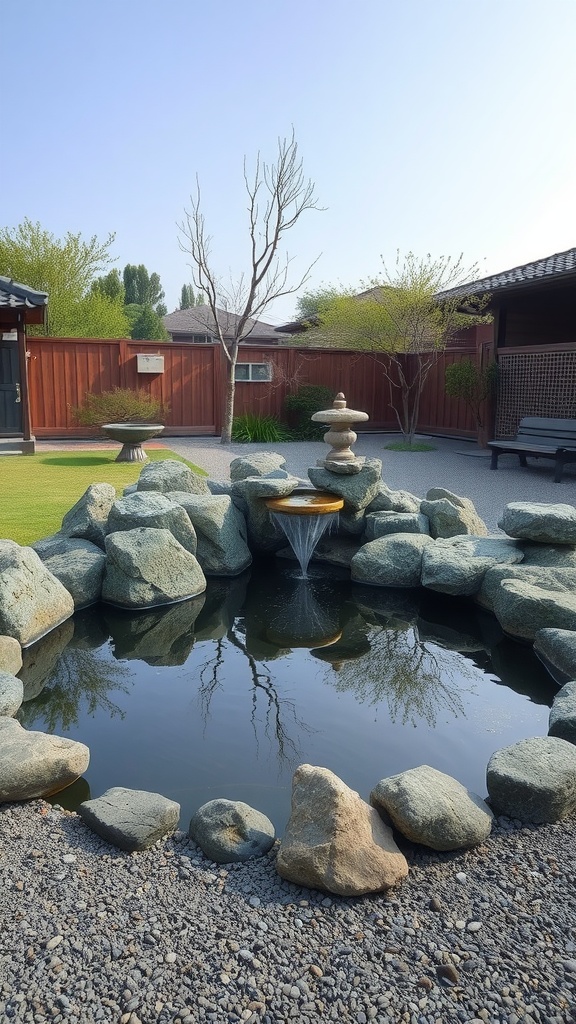
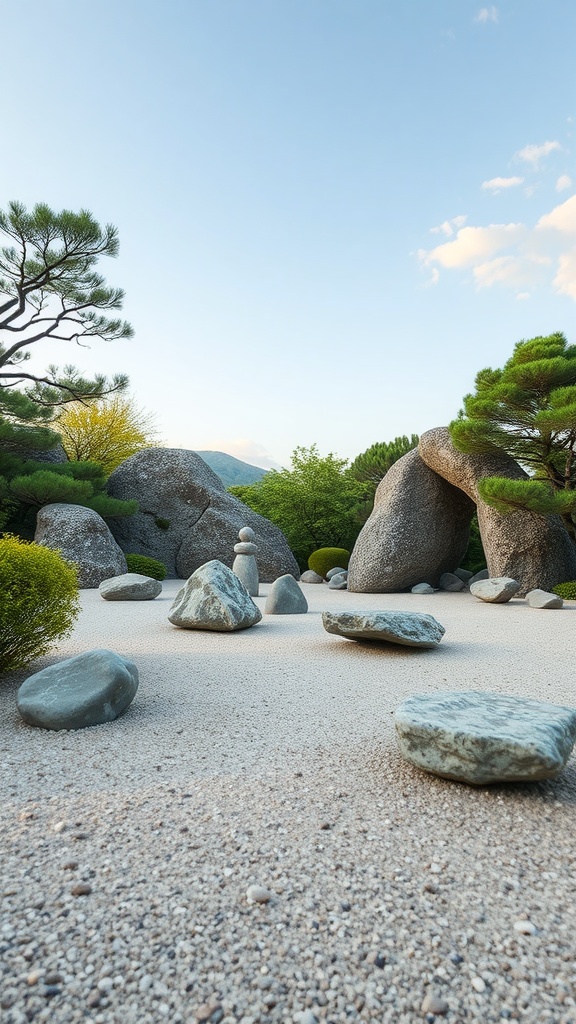
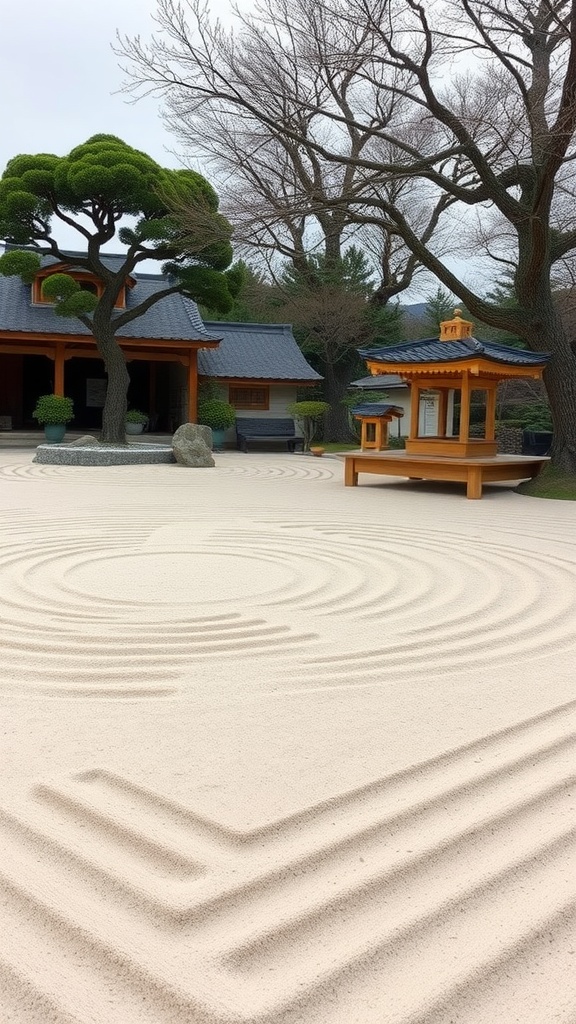
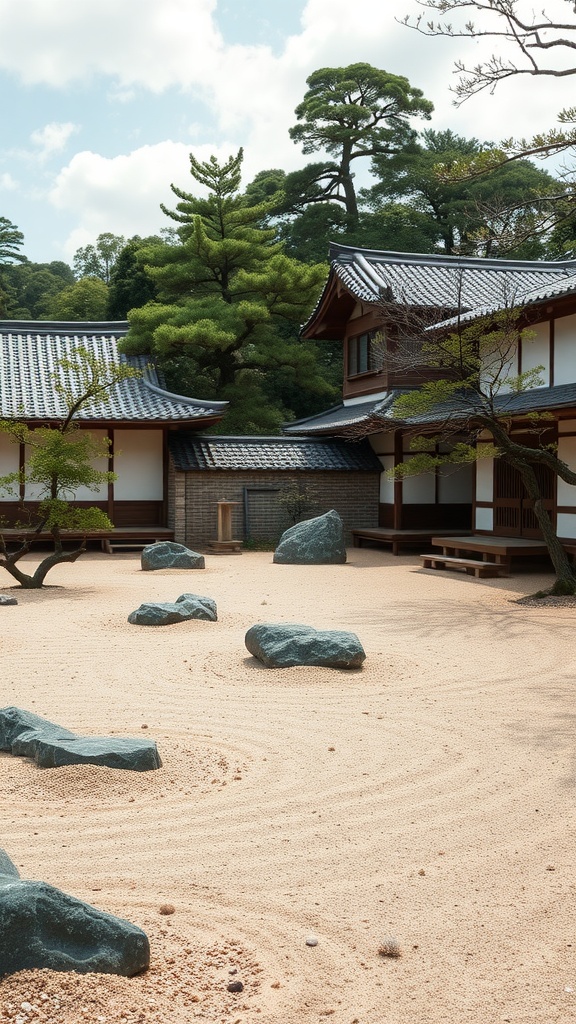
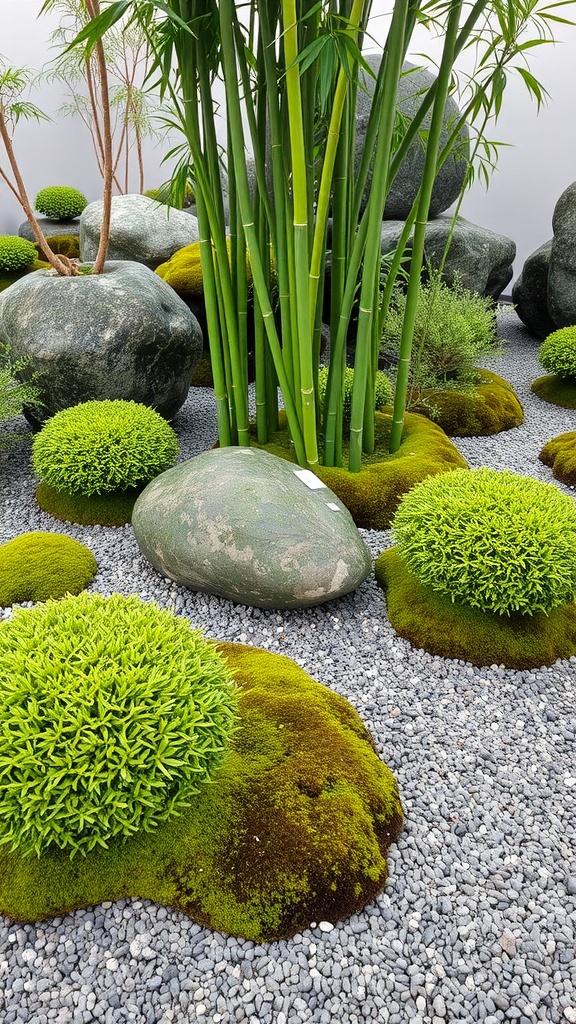
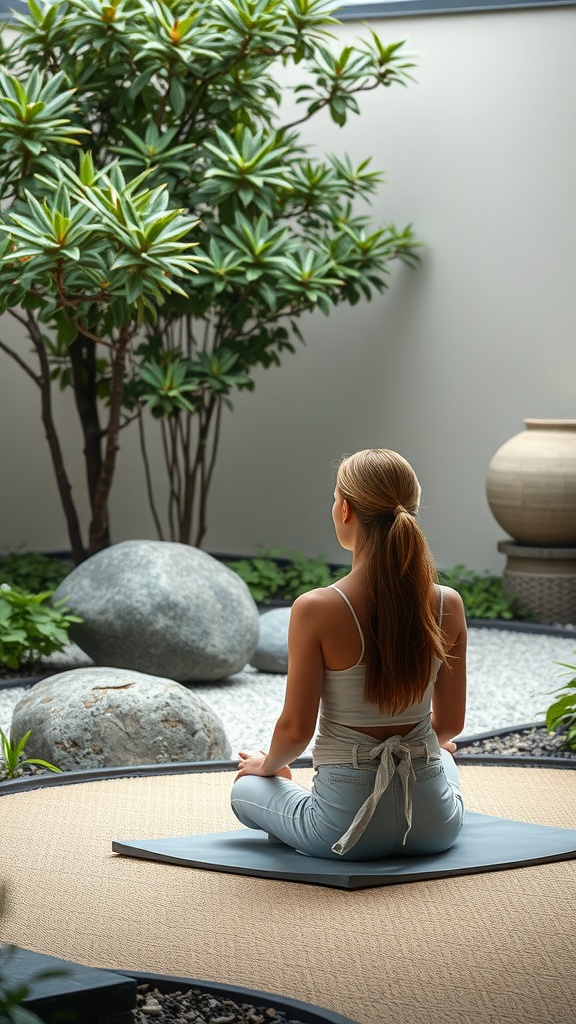
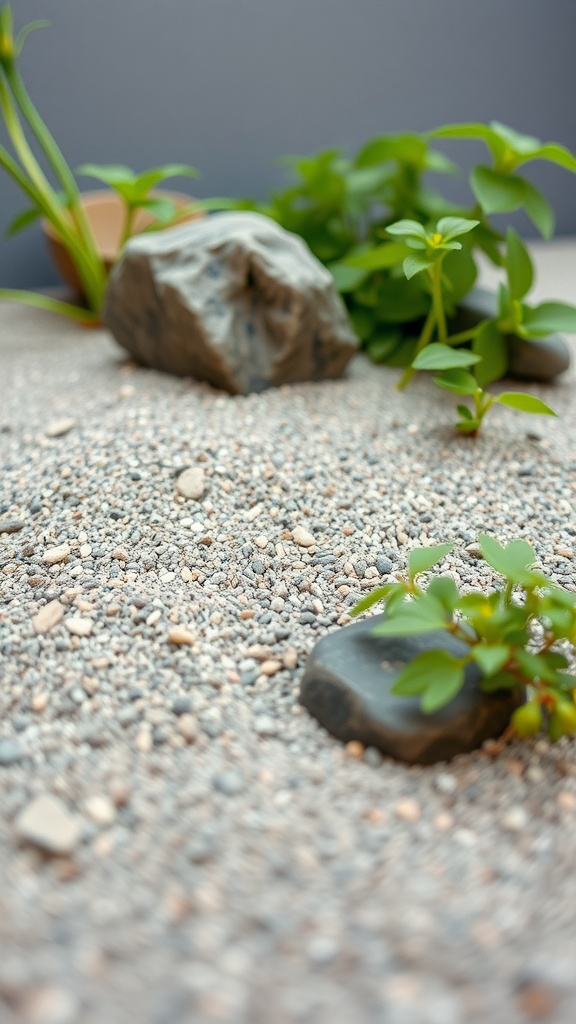

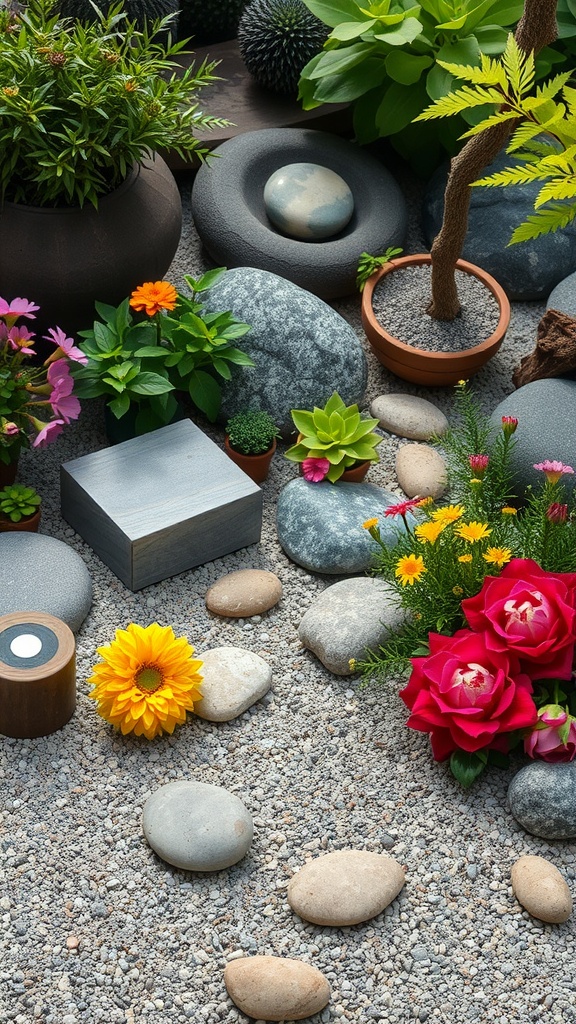
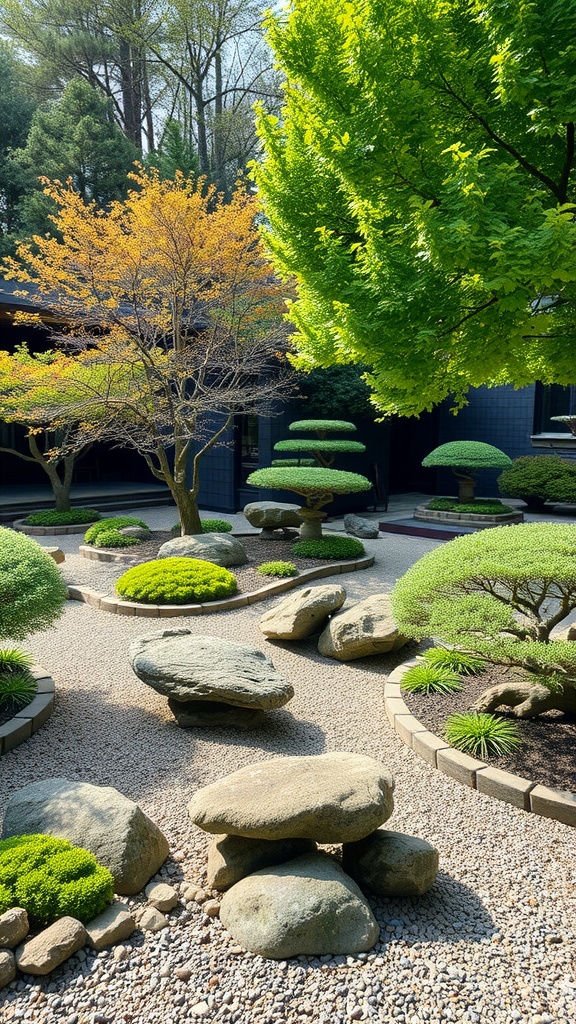


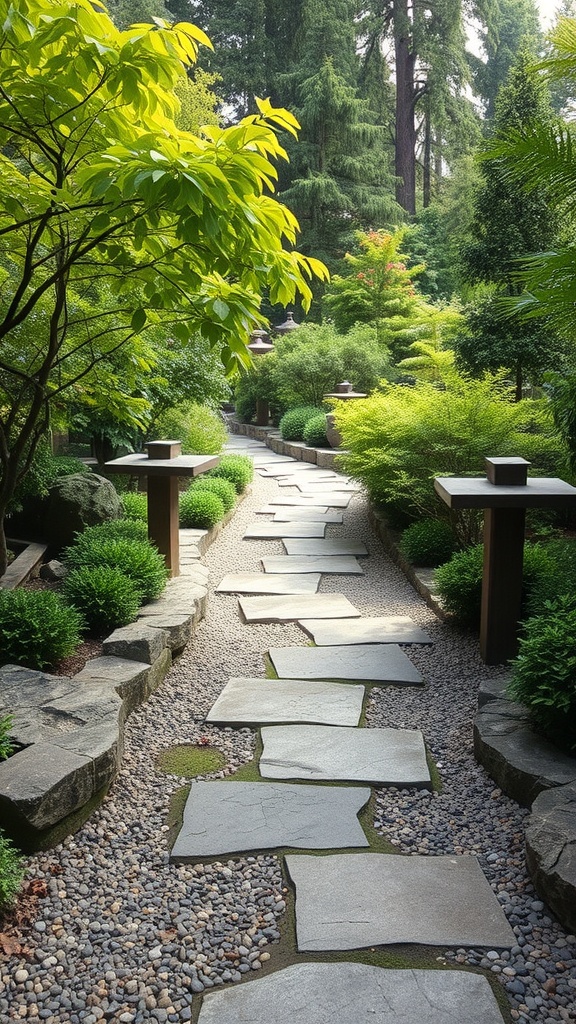
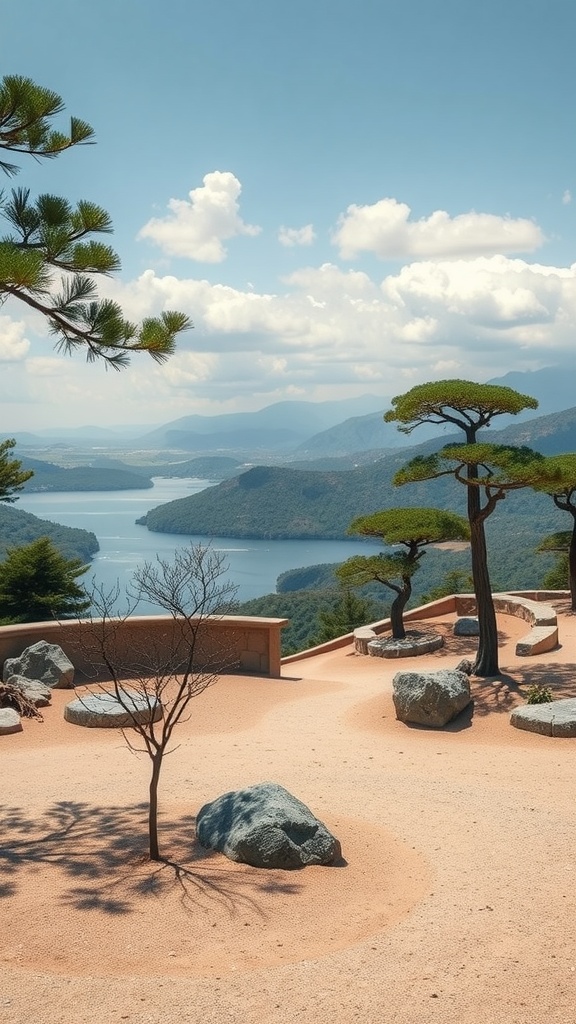
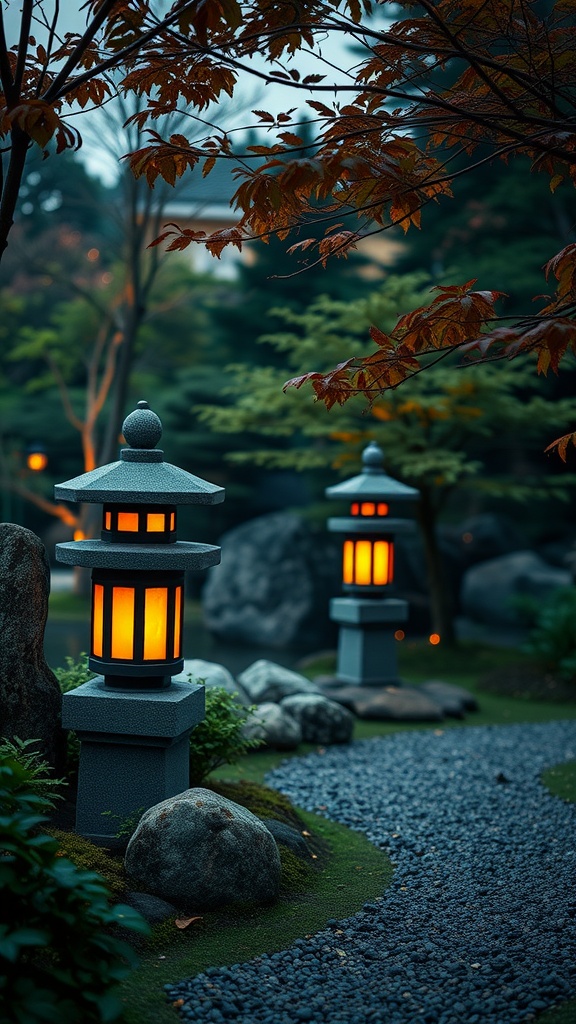
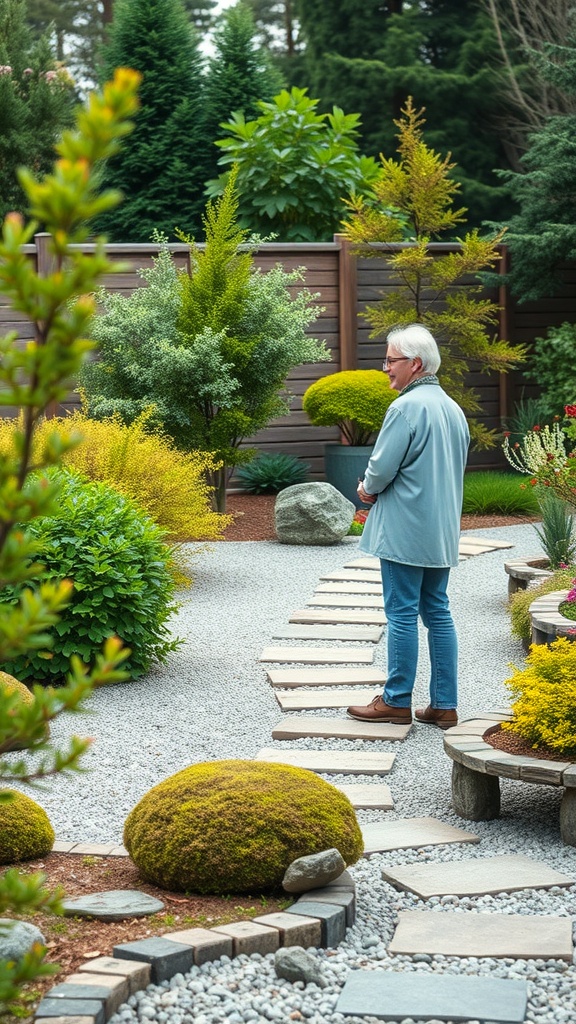
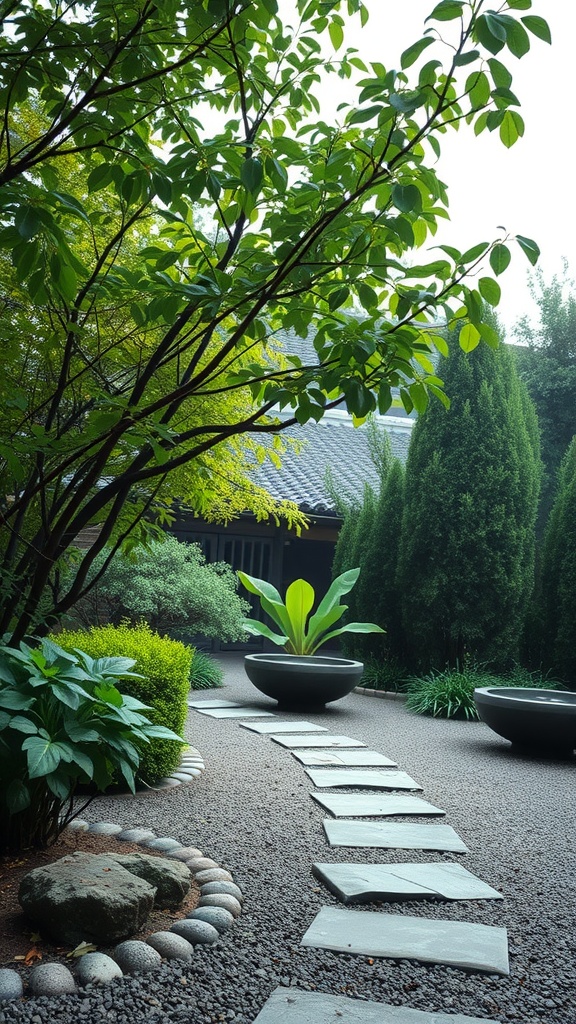
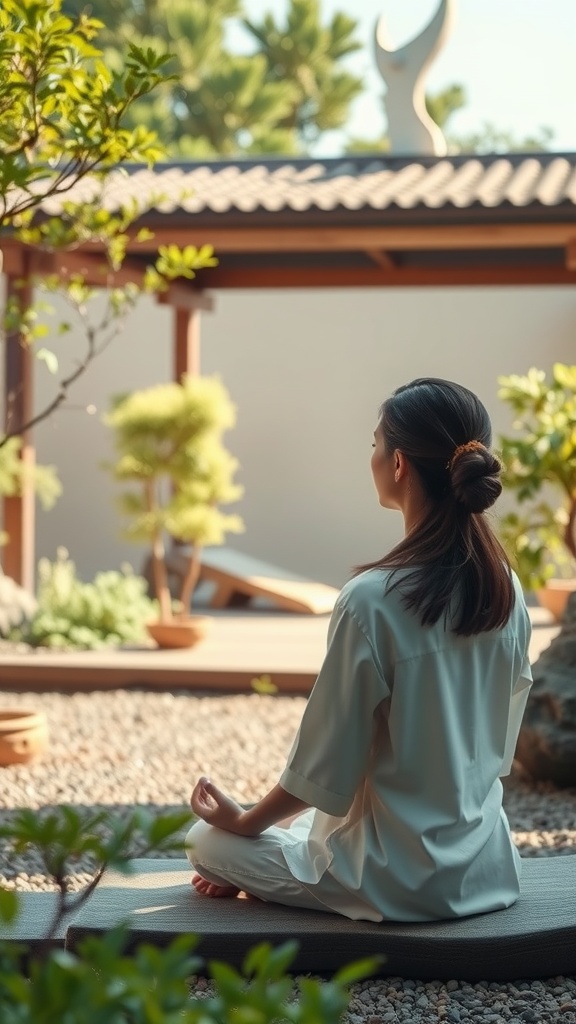
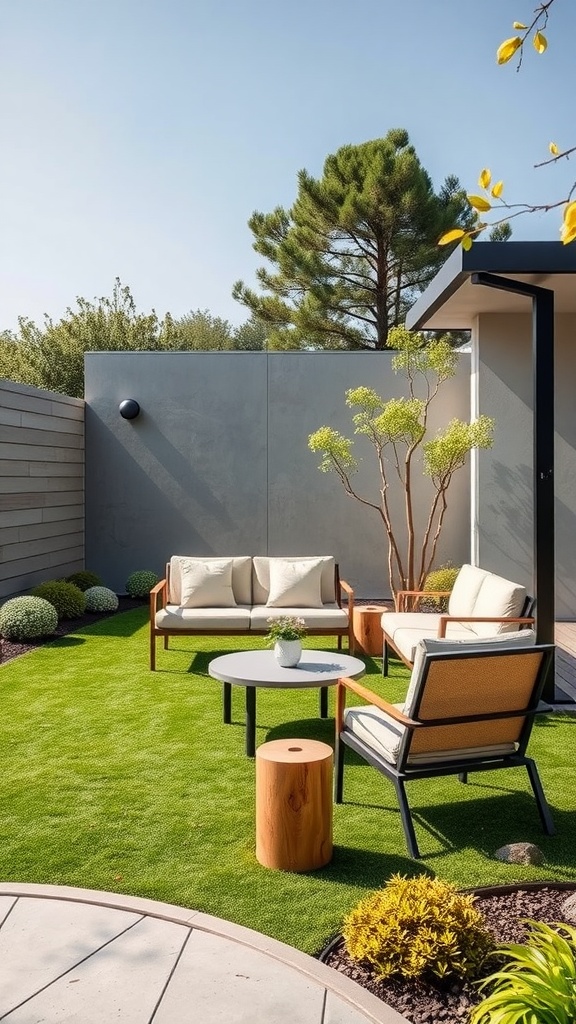

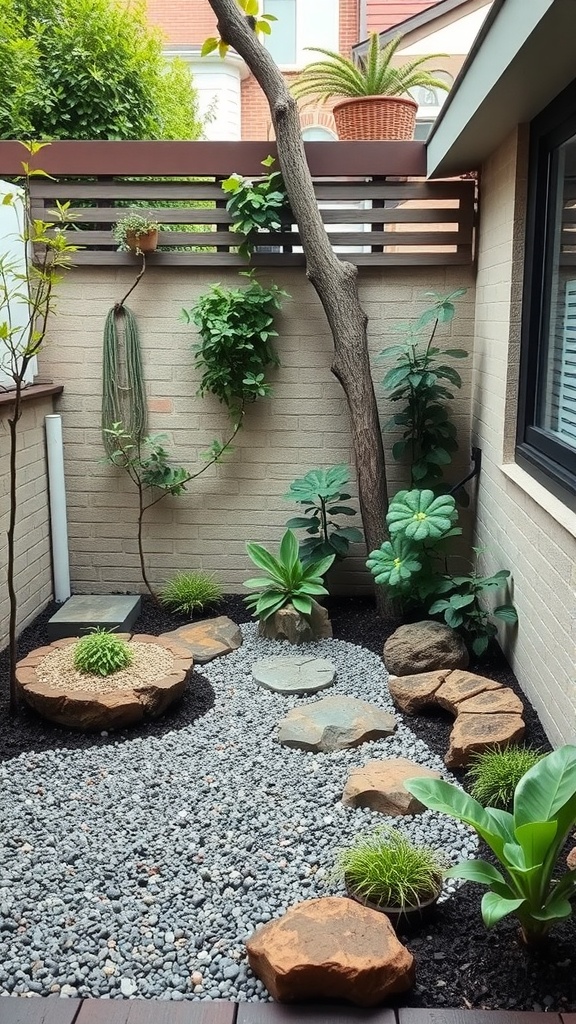
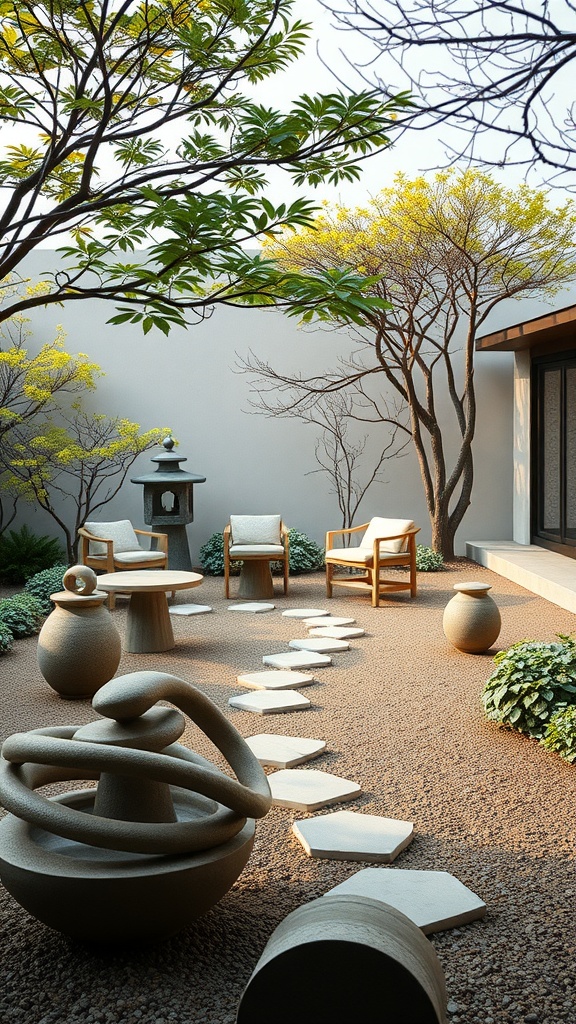

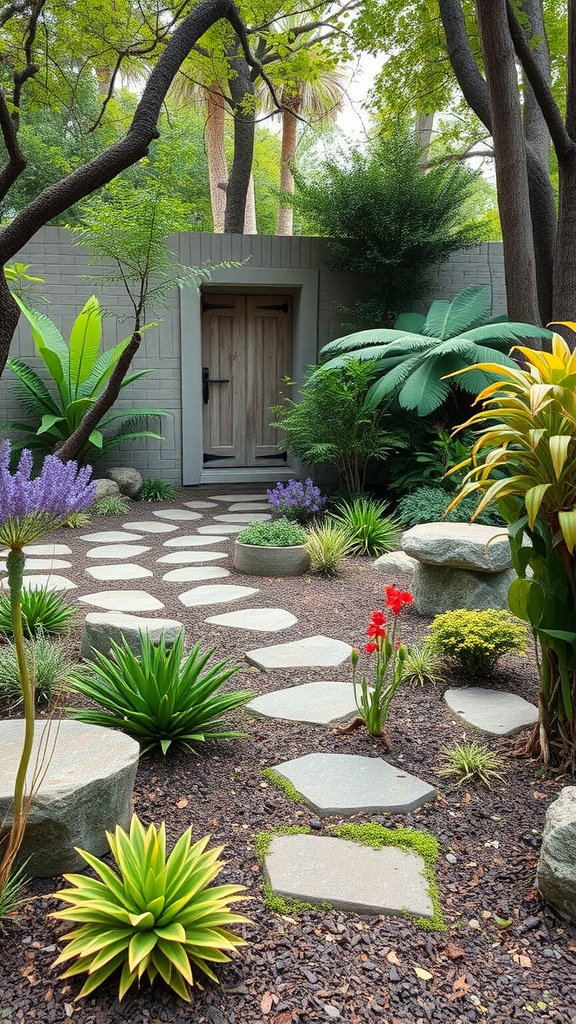
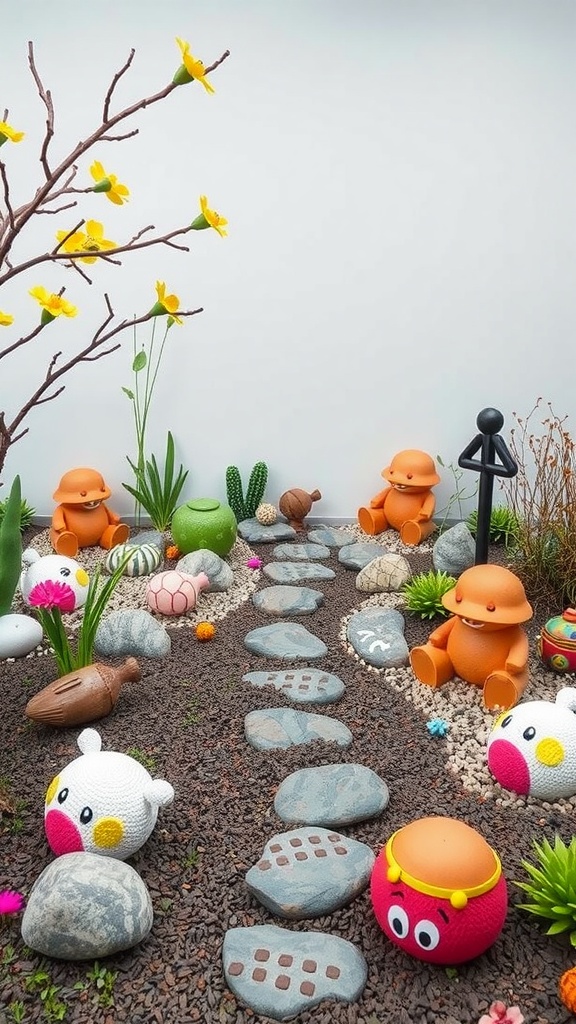
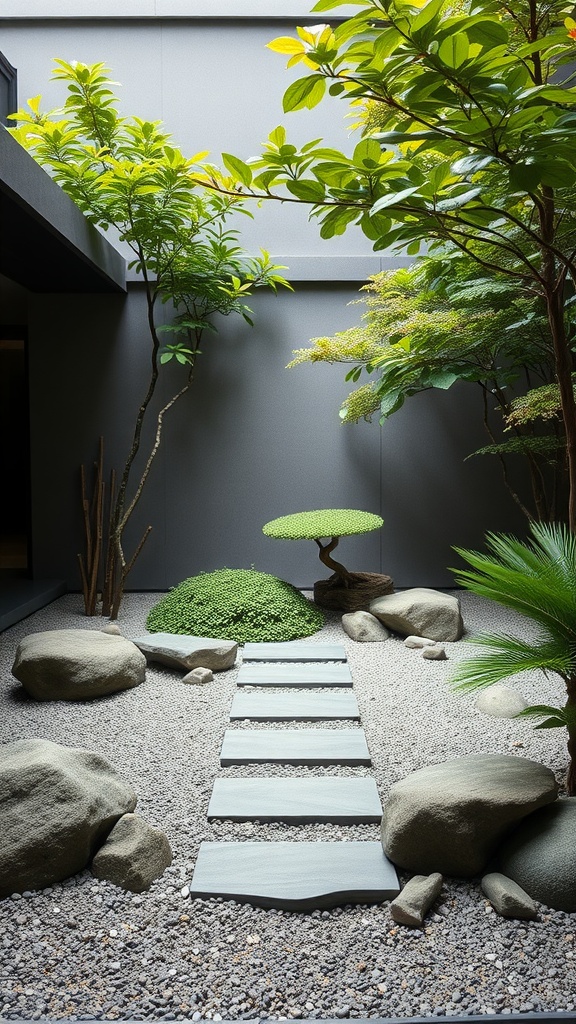
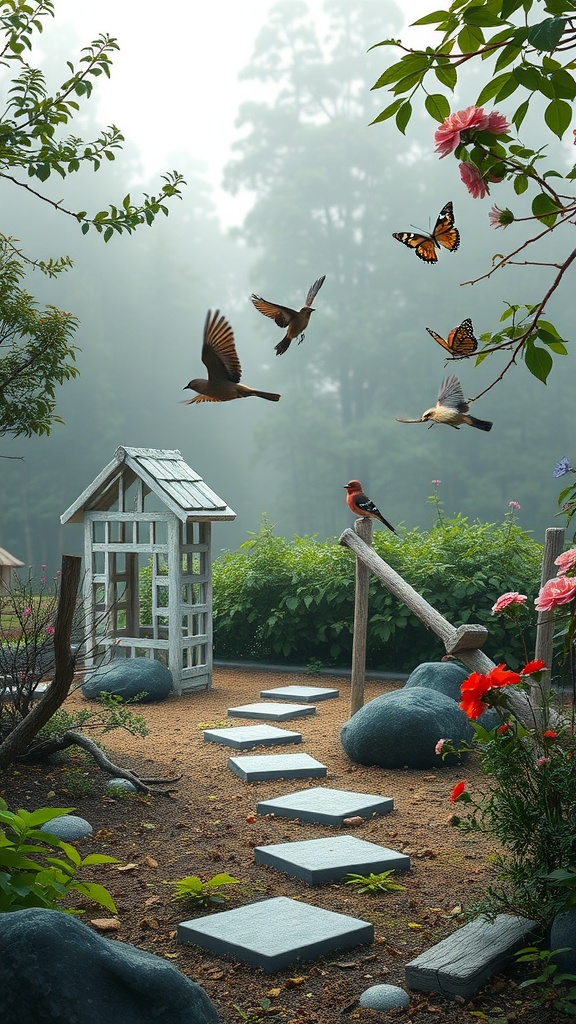
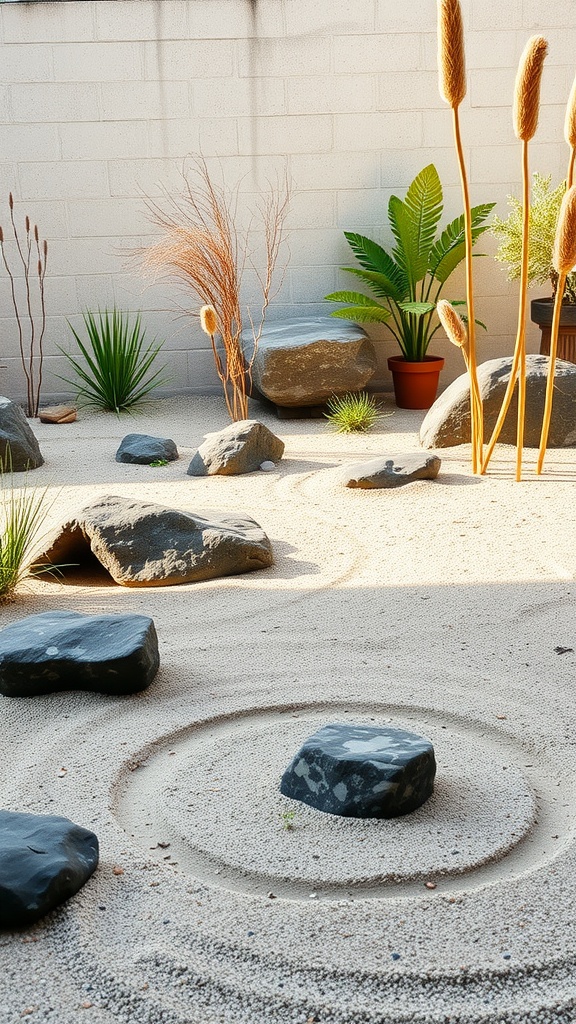
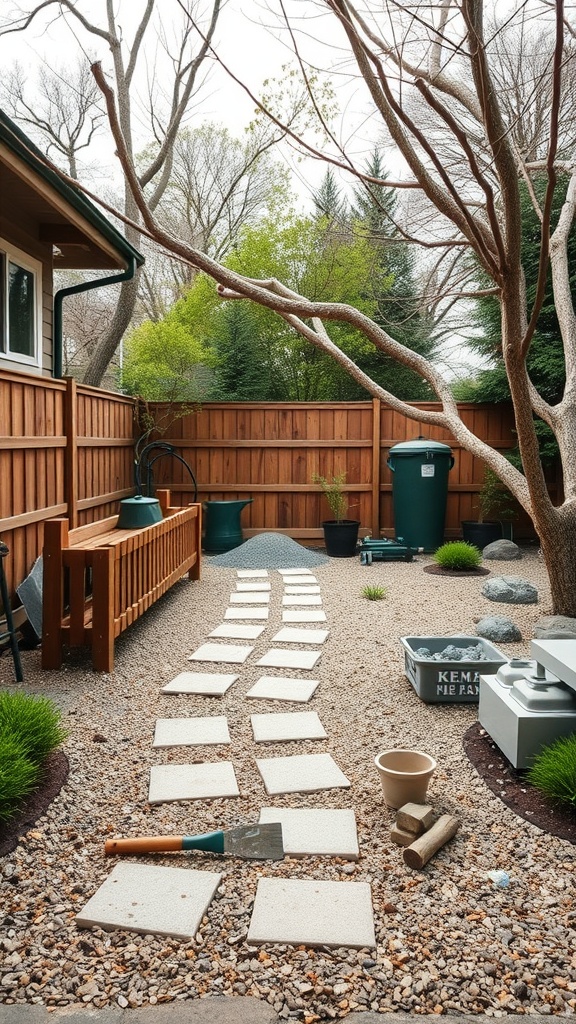

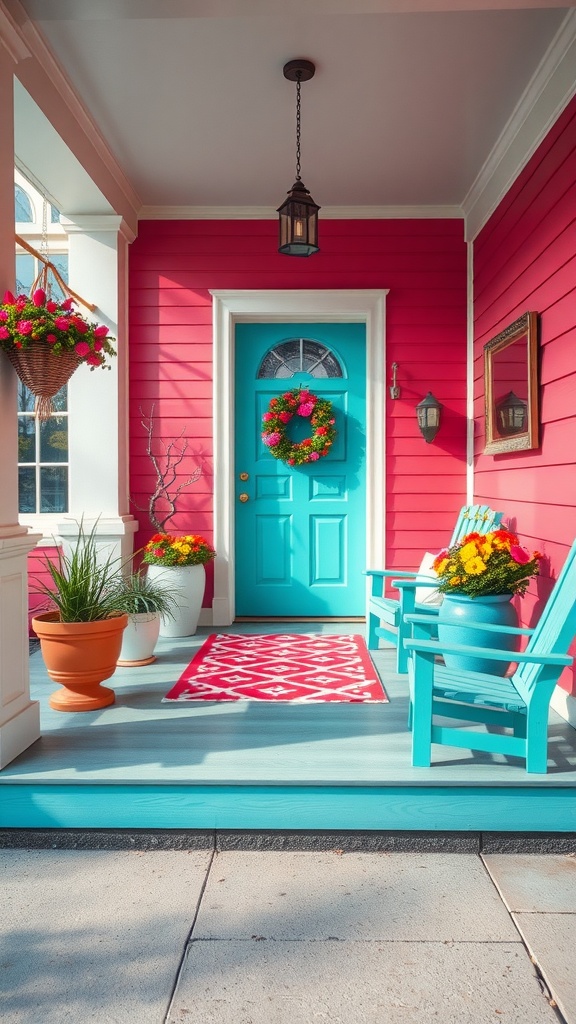


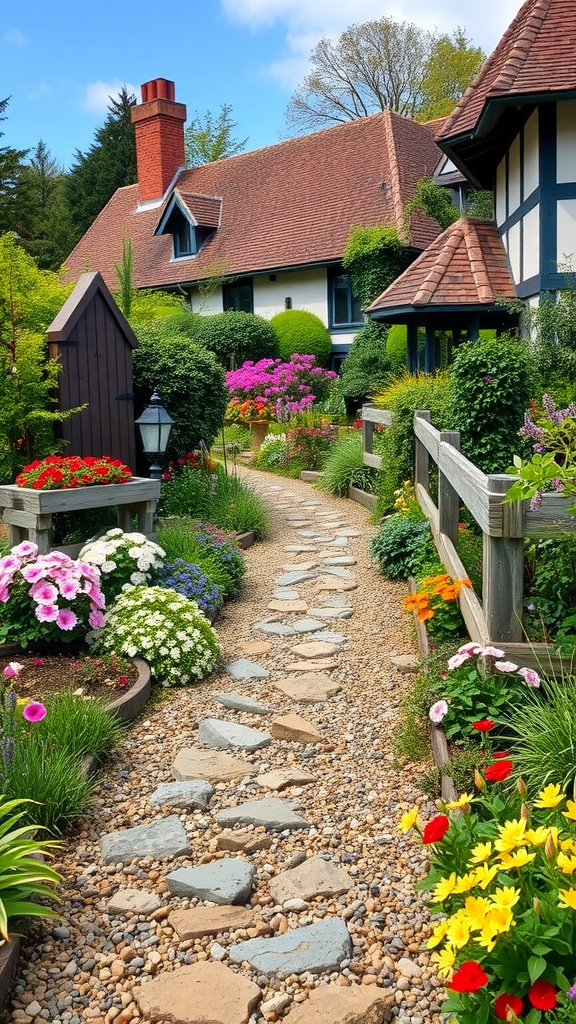
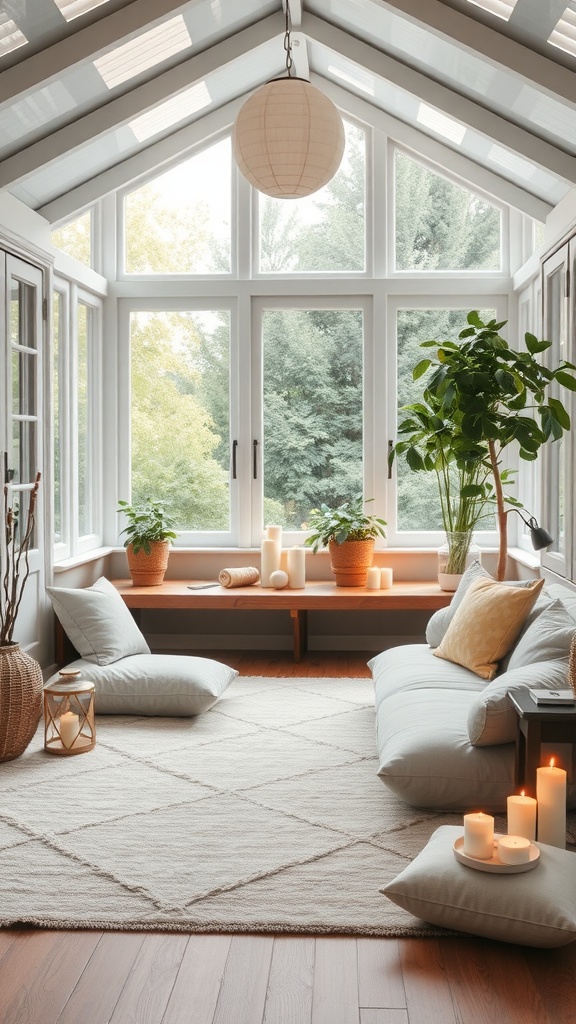
I find the simplicity and intentional design of Zen gardens truly fascinating. The way each element, like rocks and water features, is carefully placed to create harmony is inspiring. It’s amazing how such minimalistic spaces can evoke such profound feelings of peace and reflection. The idea of rocks symbolizing stability and endurance resonates deeply with me—it’s a reminder of nature’s resilience in our often chaotic lives. I especially love how water features add both beauty and a sense of vitality, attracting wildlife and creating a soothing atmosphere. I’m curious, though: how do different cultures interpret the symbolism of rocks or water in Zen gardens? Does their meaning shift depending on the context? This makes me wonder if I could incorporate some of these elements into my own space to create a small sanctuary. What do you think—could a mini Zen garden work indoors, or does it lose its essence without the open sky and natural surroundings?